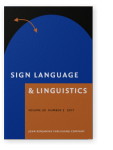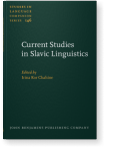Maria Kyuseva
List of John Benjamins publications for which Maria Kyuseva plays a role.
2022 Chapter 10. The qualitative lexicon in Russian Sign Language from a typological perspective The Typology of Physical Qualities, Rakhilina, Ekaterina, Tatiana Reznikova and Daria Ryzhova (eds.), pp. 289–308 | Chapter
The paper describes several expressions of physical qualities (namely, sharp, blunt, old, thick-wide, and thin-narrow) in Russian Sign Language (RSL) from a lexical typological perspective. This is the first study to analyse a sign language from the standpoint of the MLexT framework. The results… read more
2022 Chapter 2. Methodology at work: Semantic fields sharp and blunt The Typology of Physical Qualities, Rakhilina, Ekaterina, Tatiana Reznikova and Daria Ryzhova (eds.), pp. 29–56 | Chapter
The chapter illustrates the frame-based methodology of lexical typological analysis through the comparison of the qualities sharp and blunt in 21 languages. We show that these qualities tend to be asymmetrical, with bluntness being negatively defined through sharpness. The two main oppositions… read more
2017 On the notion of metaphor in sign languages: Some observations based on Russian Sign Language Sign Language & Linguistics 20:2, pp. 157–182 | Article
Metaphors in sign languages have been an important research topic in recent years, and Taub’s (2001) model of metaphor formation in signs has been influential in the field. In this paper, we analyze metaphors in signs of cognition and emotions in Russian Sign Language (RSL) and argue for a… read more
2013 Polysemy Patterns in Russian Adjectives and Adverbs: A corpus-oriented database Current Studies in Slavic Linguistics, Kor Chahine, Irina (ed.), pp. 313–322 | Article
The paper presents a research tool for studying semantic change and polysemy patterns in Russian adjectives and adverbs. It is based on a corpus analysis of high-freqency polysemous units. For each of them we describe the meanings it can have, assign to each meaning a corresponding taxonomic class,… read more


